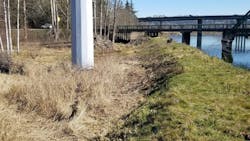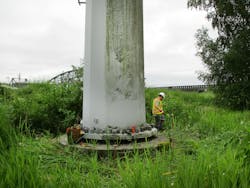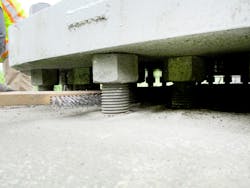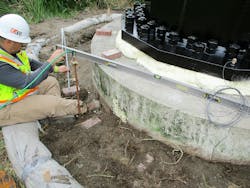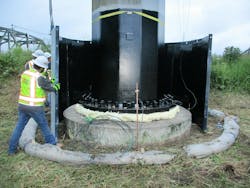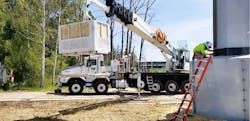The Intersection of Infrastructure and Environment
Salmon and steel transmission poles are words not often used in the same sentence in the power delivery industry. As utility professionals responsible for the infrastructure spanning the countryside through a myriad of environmental and ecological conditions, we know that wildlife can be impacted by the work we do. Is it possible to protect both with the right mindset and approach to T&D asset management?
Grid reliability has been a key tenet of utility engineering and operations efforts. In addition, grid resiliency has been seen as a crucial means to achieving a high level of reliability which society now demands, but it doesn’t have to happen at the expense of the environment. The need to preserve and protect native ecosystems often intersects our need to maximize the life and performance of our high voltage equipment.
Regardless of the operating territory, every utility at some point in time has had to coordinate with other agencies to mitigate damage or disturbance to the environment while maintaining existing or constructing new transmission lines. And often we are forced to respond to situations born from factors entirely out of our control. Snohomish County Public Utility District’s (SNOPUD) ‘SR529 Mitigation Project’ is a classic example of multiple agencies responding to an environmental need with some “out of the box” thinking.
In 2018, the Washington Department of Transportation (WSDOT) notified (SNOPUD) of their intention to create a new estuary along the Snohomish River. It would reclaim damaged wetland from years of transportation, residential and commercial development. It would also offset the future destruction of ecologically sensitive areas from future highway expansion projects. The estuary would be critical for declining local salmon populations and other connected species in the area as these wetlands represent natural habitat that are essential to young ‘smolting’ salmon making their way out to the ocean.
WSDOT’s plan was to breach the dikes of the Snohomish River that were keeping the Puget Sound tides at bay and flood adjacent land to create these new wetlands. The issue for SNOPUD was that the proposed estuary happened to encompass the right of way for a major double circuit 115kv transmission line serving the region. Once flooded, SNOPUD would have no way to access and maintain a major river crossing structure for that critical line.
It also meant that the foundation and base section of the galvanized tubular steel pole would be subject to King Tides, or high salinity tidal flows that would regularly submerge the anchor bolts and base plate. Of course, the structure was not designed or installed with this kind of exposure in mind. The risk of corrosion to the foundation would be significant.
SNOPUD had a decision to make. They could either move the line out of the intended flood zone or upgrade the affected crossing structure to withstand these new environmental conditions, knowing that once WSDOT completed their project, the only way to access this tower would be via inland barge, a costly endeavor.
Complicating this decision further was the aggressive timeline that WSDOT outlined for having all utility work completed before they intended to breach the dike of the main river. In short, all utilities within the flood zone which included Comcast, Zayo, Frontier, Century Link, Puget Sound Energy and SNOPUD, would have to either relocate or abandon the facilities.
WSDOT was planning to breach the dikes in June 2019, which left less than a year for all utilities impacted by this plan to relocate their facilities in conflict with this project. A solution was needed that could be executed in a short amount of time while providing long-lasting asset protection to ensure continued and reliable power delivery in northern Snohomish County.
Evaluating Options
Upon receiving WSDOT’s notification of the impending Estuary project, SNOPUD began to identify and evaluate the available alternatives. Unlike some of the other affected utilities, abandonment of the line was not an option. There proved to be three viable options available for consideration. The first would be to relocate the structure to an area outside of the flood zone, in a position that could be easily maintained. The second option was to construct a new access road that would cut through the new wetland and provide SNOPUD with suitable equipment and vehicle access to the transmission structure in its current position. The third and final option would be to harden and maintain the asset in place, to the best extent possible prior to flooding the area, knowing that future access would only be possible via inland barge.
After preliminary consideration of each option, cost and time eliminated the thought of line relocation, but it was agreed that a maintenance access road could be designed and installed to allow crews to access the structure. However, the structure being 125’ above ground line would require large equipment to perform proper transmission level maintenance.
WSDOT took it upon themselves to design a maintenance road within the boundaries of the mitigation area but were unable to provide a cost-effective solution that could support large enough equipment. The proposed access road could not accommodate vehicles large enough to reach the top of the structure and was estimated to cost close to half a million dollars.
This option was no longer palatable. Unfortunately, the back-and-forth process for WSDOT to design the access road and ultimately conclude that it was unusable took nearly six months. This left SNOPUD with only four months to act before construction of the estuary would begin in June 2019. The only remaining solution left for the engineering team would be to proactively upgrade all the equipment on the pole while they still had access, and to come up with a permanent hardening solution that would protect the pole and its foundation from the tides indefinitely.
SNOPUD engaged Exo, a structural engineering and field services company, to assess the situation and offer a solution. Exo had previously restored another steel pole structure for SNOPUD which had suffered severe vehicular damage and offered to engineer a barrier protection system for this unique case.
The Path Forward
Exo presented a plan that would harden the base of the pole and the top of the concrete pier foundation. With a series of barrier protection systems and cathodic protection, the structure would be protected from corrosion resulting from subsequent King Tides. The plan was cost effective and worked within the short time constraints of WSDOT’s construction timetable. SNOPUD made the decision to move forward and began planning out a schedule for the project.
The schedule would have to allocate time for acquiring permits through WSDOT for working in the environmentally sensitive area as well as traffic control to get large vehicles into the job site. It would also need to accommodate notice for de-energizing transmission lines to perform maintenance, time to prepare the site for structure access, time for performing maintenance work and finally a few days for EXO to install their solution.
WSDOT required specific traffic control be in place because the job site was located right off SR529. This meant a Traffic Control Consultant would be needed to implement the plan. Site access was challenging and to prepare for the heavy equipment necessary to replace insulators and associated hardware, the area was cleared of brush and temporary matting was installed.
Structure Hardening
Once all of the necessary permits were acquired from WSDOT, the roughly two-week project was ready to begin, with a completion time just days ahead of the scheduled start of the estuary construction project. After matting was installed, Exo would begin work on the pole foundation.
The solution involved applying protective coating to the exposed portions of the anchor bolts and the portion of the steel pole that would be exposed to a King Tide, or water levels three to four feet above the base plate. Exo selected a moisture cured coal tar urethan product (Induratar MC) for the coating system and followed the manufacturer’s recommended surface preparation protocols carefully. Proper surface preparation and application is crucial to the long-term performance of any coating, and this coating would be the primary layer of protection for the structure.
Once the coating system was installed and dry to touch, high density closed cell foam was applied between the top of the concrete pier and the bottom side of the baseplate, enveloping the anchor bolts. High density closed cell foam does not absorb moisture which makes it an effective second layer moisture barrier protecting the anchor bolts.
The third layer of protection came from a cathodic protection system installed using sacrificial anodes. Once the coating, foam, and cathodic protection were in place, a final physical barrier was installed to protect those systems from any kind of disturbance which may compromise their effectiveness.
A steel caisson was designed to fit around the base of the structure. Once secure, the annular space between the caisson and pole shaft were filled with concrete. Overall, the hardening process took three days, with the crews working overnight for the concrete pour due to permitting and traffic control constraints. As a complete system, this combination of protective elements will safeguard the base of the structure from moisture or physical damage for many years to come.
Preemptive Pole Maintenance
Once Exo had completed their work at the base of the structure, SNOPUD teams were able to come and perform preemptive maintenance by upgrading the insulators and hardware up pole. This type of action would become many times more expensive due to lack of access once the area was flooded, making the decision to upgrade now an easy choice. In fact, any future access would require an inland barge on the river side of the embankment to work on the structure.
Conclusion
Ultimately, the field work to harden the base of the structure and upgrade the electrical equipment took fourteen days to complete, with several days requiring work at night for traffic control reasons on the busy state highway 529. The project concluded on June 6, 2019, just over a week prior to the start of the wetland reclamation and estuary construction project by WSDOT.
From initial engagement with Exo to completed execution was a project duration of just under four months. In that time, a permanent solution was developed to protect the base of the steel pole and foundation system from tidal flows and potential severe corrosion. Permits for traffic control and access to environmentally sensitive areas were acquired on an expedited schedule.
The steel caisson was designed and fabricated, and all other materials needed for the upgrade were procured. The outcome was optimal in the sense that both budget and strict time constraints were satisfied based on WSDOT’s program requirements. The end result was a hardened and secure crossing structure that could continue to support a vital transmission line for the community of Snohomish County many years into the future, despite very difficult access moving forward.
And equally important was the successful creation of the new estuary. It is an environmentally important habitat that is critical to strengthening local salmon populations and other important marine life. It’s an ecological habitat that represents a major part of the culture and history of the region, which is a win-win for the ecosystem and the power grid!
About the Author
Grant Leaverton
Grant Leaverton works as a Senior Account Manager for Exo helping clients solve structural integrity issues with critical transmission and substation assets. He has been in the utility industry for 11 years and holds a B.S. in Industrial Engineering from Texas A&M University and an MBA from Southern Methodist University.
